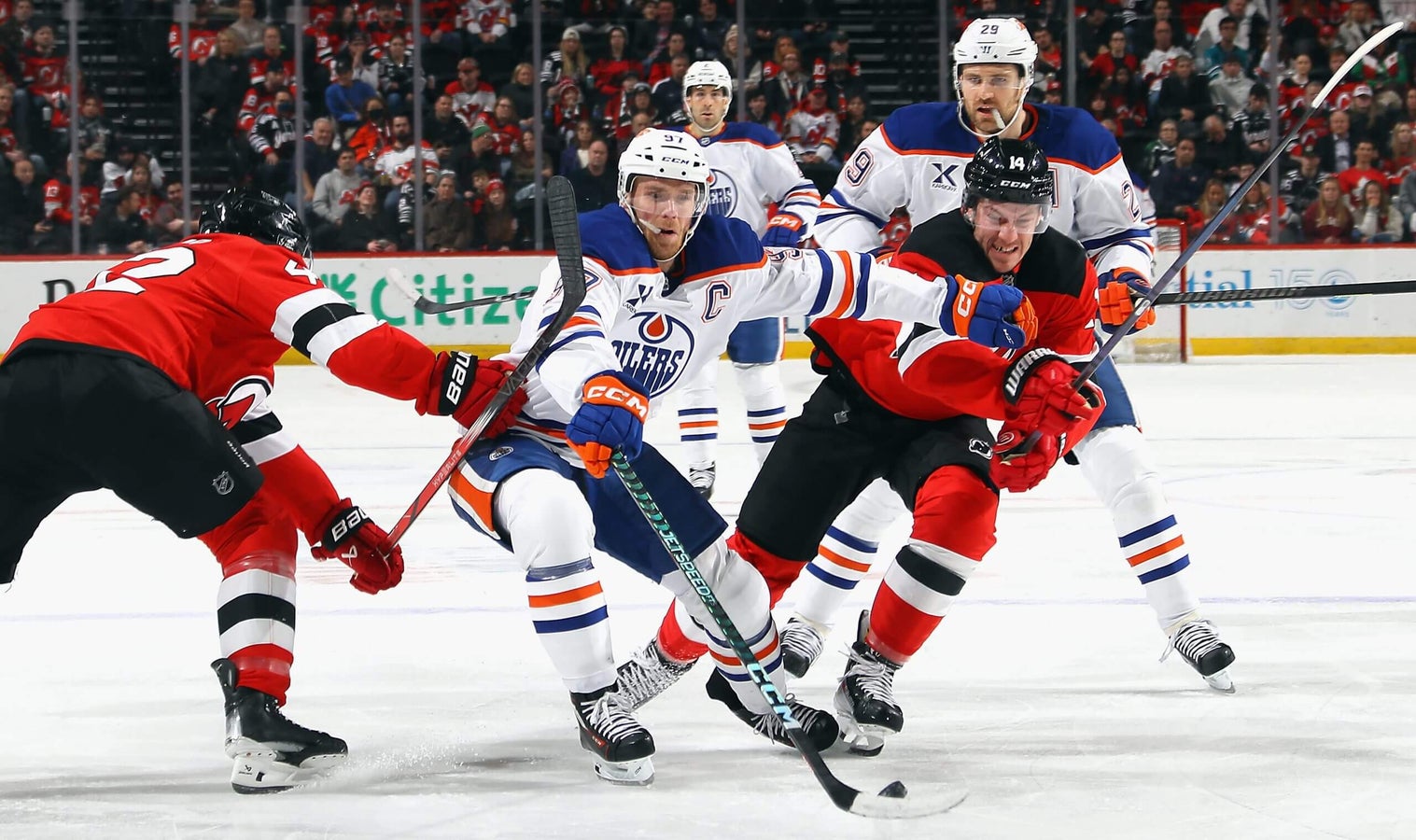How the Edmonton Oilers’ Deployment Versus Elites Offers Some Surprises
The Edmonton Oilers, widely known for their offensive firepower led by Connor McDavid and Leon Draisaitl, have built a reputation as one of the most potent teams in the NHL. Their ability to score in bunches, especially on the power play, has been well-documented. However, it is not just their star power that makes them an intriguing team. As the NHL continues to evolve into a more strategically-driven league, the Oilers’ approach to deploying their roster against elite teams has become one of the most interesting storylines this season. With a combination of tactical nuances, player utilization, and coaching decisions, the Oilers’ deployment strategy has provided some surprising elements that go beyond their well-known offensive brilliance.
This article takes a closer look at how the Edmonton Oilers’ deployment against elite teams has produced surprising results, both positively and negatively, and how coach Jay Woodcroft and his staff are utilizing their players in ways that not only highlight their star power but also look to exploit the weaknesses of top-tier opposition.
The Importance of Matchups in the Modern NHL
The modern NHL has seen an increasing emphasis on tactical matchups. Coaches now use their team’s depth, analytics, and advanced data to design lineups that exploit opponents’ weaknesses while minimizing their own team’s vulnerabilities. This is particularly crucial when facing top-tier teams, as elite squads are often strong in multiple facets of the game. In years past, many teams would focus solely on matching up their best players against the opposition’s top lines, but today’s strategies go far beyond this.
For the Edmonton Oilers, the challenge is balancing the overwhelming offensive potential of McDavid and Draisaitl with the defensive needs of the team. While McDavid is arguably the best player in the league, it’s not just about giving him the most minutes or putting him on the ice for every key situation. Instead, it’s about finding the right mix of personnel that will help the Oilers contain their opponent’s top lines while also maximizing their offensive chances.
Jay Woodcroft, the Oilers’ head coach, has strategically used different deployment strategies against elite teams, aiming to leverage his team’s strengths while minimizing potential weaknesses. The surprising deployment tactics have led to some unexpected outcomes, particularly in how the Oilers play against other contending teams, and how they set themselves up for success in the long run.
McDavid and Draisaitl: The Obvious Star Power
At the center of the Oilers’ deployment strategy is the dynamic duo of Connor McDavid and Leon Draisaitl. The two are among the best players in the world, and their offensive chemistry has made them an almost unstoppable force. However, the Oilers’ deployment of these two players against elite teams is more nuanced than simply putting them on the ice together as often as possible. Coach Woodcroft has adopted a more calculated approach when deciding how and when to deploy McDavid and Draisaitl against top competition.
Matching Against Elite Defenders
One of the more interesting tactics Woodcroft has utilized is matching McDavid and Draisaitl against opposing elite defenders. While it’s tempting to always pair McDavid with Draisaitl to maximize their offensive production, Woodcroft has often separated the two for specific matchups. The reasoning behind this is to prevent elite defenders from being able to match up against both of Edmonton’s star players simultaneously. By deploying McDavid and Draisaitl on separate lines, the Oilers have a greater chance of ensuring one of the two can exploit weaknesses in the opposition’s defense.
For instance, against top teams with deep defensive pairings like the Colorado Avalanche or the Carolina Hurricanes, Woodcroft has sometimes deployed McDavid against one pairing and Draisaitl against another, ensuring that at least one of them is up against a less dominant defender. This strategy allows the Oilers to create favorable matchups on the ice, potentially leading to higher scoring chances.
Moreover, McDavid’s speed and ability to disrupt defensive structures create issues for even the most elite defensemen. By strategically matching McDavid against a specific defensive pair, Woodcroft can use McDavid’s speed to expose even the most well-regarded defenders. Draisaitl’s size, vision, and ability to win battles along the boards create different challenges, which is why splitting the two up allows the Oilers to maximize their offensive potential.
Special Teams and the Power Play
When it comes to the Oilers’ power play, McDavid and Draisaitl are the focal points, and their deployment on the man advantage is a critical area where Woodcroft often surprises opposing teams. In games against elite teams with strong penalty kills like the Boston Bruins or the Tampa Bay Lightning, the Oilers’ power play is an area where they can dominate if deployed effectively.
One surprising element of Woodcroft’s approach is how he occasionally uses Ryan Nugent-Hopkins and Zach Hyman in unorthodox roles on the power play. For example, Nugent-Hopkins, traditionally a distributor, has occasionally been tasked with shooting duties to add another layer to the Oilers’ man advantage. This subtle shift in deployment forces opponents to consider different defensive strategies and opens up more opportunities for McDavid and Draisaitl to find space.
Woodcroft’s ability to adjust the Oilers’ power-play tactics depending on the opponent is one of the more surprising aspects of the team’s deployment. The Oilers’ power play is historically one of the best in the league, and Woodcroft ensures that the unit stays unpredictable when facing elite teams.
Defensive Matchups: Surprising Adjustments
While the Oilers’ offense is well known, their defensive deployment is what has raised eyebrows, especially when they face elite teams. Over the years, Edmonton has made strides in improving their defensive depth, and the addition of key players such as Mathew Barzal and Mattias Ekholm has strengthened their blue line.
Ekholm’s Role and Pairing Adjustments
One of the biggest surprises in the Oilers’ deployment strategy against top teams has been the role of Mattias Ekholm. Known for his stability, experience, and defensive prowess, Ekholm has often been deployed against elite forwards on the opposition’s top line. The 6’4″, 215-pound defenseman has played a critical role in the Oilers’ defensive unit, not just as a physical presence but also as someone who can read the game and shut down high-scoring players.
Ekholm’s ability to lock down elite players is a key part of Woodcroft’s strategy. Whether it’s against the Florida Panthers’ high-octane offense or the Toronto Maple Leafs’ powerful top-six forwards, Ekholm has often been tasked with matching up against the opposition’s biggest threats. His pairing with Darnell Nurse has also created a formidable shutdown duo, allowing the Oilers to have a more defensive-minded pairing while the offense is carried by other units.
Matchups Against Fast Teams
The deployment of Ekholm and the use of Cody Ceci and Brett Kulak in specific situations allows the Oilers to be more competitive against fast, skilled teams. Speed has been an issue for the Oilers in years past, particularly against teams with strong transitional games, like the Colorado Avalanche or Minnesota Wild. However, Ekholm’s ability to break up plays with his intelligence and physicality gives Edmonton a key asset in slowing down fast, skilled attackers.
In specific games, Woodcroft has deployed Ekholm and Nurse together against fast teams in an attempt to disrupt the opposition’s ability to generate quick offensive transitions. By doing so, the Oilers mitigate the risk of being caught off guard by a fast break or an odd-man rush.
The Role of Depth Players: Unconventional Utilization
Another surprising element of Edmonton’s deployment against elite teams is how Coach Woodcroft has used his depth players. Traditionally, the Oilers are known for their high-powered top six, but as the team has grown deeper, Woodcroft has been able to rely on secondary players like Kailer Yamamoto, Jesse Puljujärvi, and Evander Kane to step up in crucial moments.
Evander Kane’s Power Forwarding Against Physical Teams
Against physical teams like the Dallas Stars or the St. Louis Blues, where grinding, physical hockey is often a factor, the deployment of Evander Kane has been key. Kane’s ability to control the puck, his strength on the forecheck, and his scoring touch have made him a perfect fit against teams that pride themselves on their physical play. Woodcroft has used Kane in these matchups to provide the Oilers with the necessary physical presence that can disrupt elite defensive players while also providing offensive output.
Yamamoto’s Defensive Contributions
On the defensive end, Kailer Yamamoto has been deployed in a variety of roles, with Woodcroft utilizing him against elite defensive players in certain situations. Yamamoto’s work ethic and defensive responsibility have allowed the Oilers to create a balanced attack against top teams, especially when dealing with top defensive lines.
The Surprising Strategy Pays Dividends
The Edmonton Oilers’ deployment strategy against elite teams has been a surprising and effective component of their overall success. Coach Jay Woodcroft has shown a keen understanding of how to balance the offensive brilliance of McDavid and Draisaitl with the team’s defensive responsibilities. By strategically utilizing matchups and adjusting to the strengths and weaknesses of top teams, Woodcroft has given the Oilers a competitive edge that goes beyond simply relying on their star power.
The Oilers’ ability to deploy different lines and pairings against elite competition has been one of the key elements in their continued success. While much of the attention will remain on McDavid’s individual brilliance, it’s clear that the tactical decisions behind Edmonton’s deployment are what have made them a serious contender in the league. As they continue to push toward a potential Stanley Cup run, the surprising deployment strategies of the Edmonton Oilers could very well be the difference-maker in their quest for postseason glory.



